Research on Injection-Production Capability and Seepage Characteristics of Multi-Cycle Operation of Underground Gas Storage in Gas Field—Case Study of the Wen 23 Gas Storage
Abstract
:1. Introduction
2. Field Description
2.1. Reservoir Location and Characteristics
2.2. Petrophysical Characteristics of the Reservoir
3. Experimental Samples and Methods
3.1. Multi-Cycle Formation Damage Evaluation by Flow Test
- The confining pressure was gradually increased to 5, 10, 20, 30, 40, and 50 MPa while measuring the permeability and porosity of the core samples, respectively.
- The confining pressure was gradually reduced to 50, 40, 30, 20, 10, and 5 MPa while measuring the permeability and porosity of core samples, respectively.
- Steps 2 and 3 were repeated three times.
- At the end of the experiment, the data were analyzed comprehensively.
3.2. Physical Simulation Experiment of Multi-Cycle Injection and Production in UGS
- Simulation of gas reservoir accumulation. Firstly, gas was injected from the left end of the core holder. When the core was driven from the saturated water state to the bound water state, the right end of the holder was closed. Then, gas was injected slowly from the left end of the core to reach the required reservoir pressure.
- Simulation of gas reservoir exploitation. Gas was produced via constant flow from the left end of the core to reach the required depletion pressure of the gas reservoir. No water invasion was present in the simulation of the pre-UGS gas zone at this stage.
- Simulation of multicycle injection-production in UGS. Firstly, gas was injected at high speed from the left end of the core to reach the upper pressure limit of the UGS operation, 38 MPa. Then, after the pressure distribution in the core was balanced, gas was produced at high speed from the left end of the core to the lower pressure limit of the UGS operation, 18 MPa. The injection-production process was repeated to complete six injection-production cycles. No water invasion was present in either the simulation of the pre-UGS gas zone or the gas-drive-water gas zone during this stage.
4. Results and Discussion
4.1. Characteristics of the Stress Sensitivity of Permeability and Porosity
4.2. Characteristics of Multi-Cycle Injection and Production Flow in the Pre-UGS Gas Zone
4.2.1. Variation Characteristics of Gas Saturation in the Pre-UGS Gas Zone
4.2.2. The Rules of Reserve Utilization in the Pre-UGS Gas Zone
4.3. Characteristics of Injection-Production Flow in the Gas-Drive-Water Gas Zone
4.3.1. Variation Characteristics of Gas Saturation in the Gas-Drive-Water Gas Zone
4.3.2. The Rules of Reserve Utilization in the Gas-Drive-Water Gas Zone
4.4. Characteristics of Injection-Production Flow in the Gas-Water Transition Zone
4.4.1. Variation Characteristics of Gas Saturation in the Gas-Water Transition Zone
4.4.2. The Rules of Reserve Utilization in the Gas-Water Transition Zone
5. Conclusions
Author Contributions
Funding
Conflicts of Interest
References
- De Santis, D.; Mason, J.A.; James, B.D.; Houchins, C.; Long, J.R.; Veenstra, M. Techno-economic analysis of metal-organic frameworks for hydrogen and natural gas storage. Energy Fuels 2017, 31, 2024–2032. [Google Scholar] [CrossRef]
- Razmjoo, A.; Shirmohammadi, R.; Davarpanah, A.; Pourfayaz, F.; Aslani, A. Stand-alone hybrid energy systems for remote area power generation. Energy Rep. 2019, 5, 231–241. [Google Scholar] [CrossRef]
- Pao, H.T.; Fu, H.C. Renewable energy, non-renewable energy and economic growth in Brazil. Renew. Sustain. Energy Rev. 2013, 25, 381–392. [Google Scholar] [CrossRef]
- Wang, X.; Economides, M.J. Purposefully built underground natural gas storage. J. Nat. Gas Sci. Eng. 2012, 9, 130–137. [Google Scholar] [CrossRef]
- Mazarei, M.; Davarpanah, A.; Ebadati, A.; Mirshekari, B. The feasibility analysis of underground gas storage during an integration of improved condensate recovery processes. J. Pet. Explor. Prod. Technol. 2019, 9, 397–408. [Google Scholar] [CrossRef] [Green Version]
- Zhang, G.; Li, B.; Zheng, D.; Ding, G.; Wei, H.; Qian, P.; Li, C. Challenges to and proposals for underground gas storage (UGS) business in China. Nat. Gas Ind. B 2017, 4, 231–237. [Google Scholar] [CrossRef]
- Alim, C.N.; Tohidi, B. A flow assurance evaluation of gas storage in depleted reservoirs. In Proceedings of the Nigeria Annual International Conference and Exhibition, Lagos, Nigeria, 10–12 August 2012; pp. 1–13. [Google Scholar]
- Juez-Larre, J.; Remmelts, G.; Breunese, J.; Van Gessel, S.; Leeuwenburgh, O. Using underground gas storage to replace the swing capacity of the giant natural gas field of Groningen in the Netherlands. A reservoir performance feasibility study. J. Pet. Sci. Eng. 2016, 145, 34–53. [Google Scholar] [CrossRef]
- Aminian, K.; Brannon, A.; Ameri, S. Gas storage in a depleted gas/condensate reservoir in the appalachian basin. In Proceedings of the SPE Eastern Regional Meeting, Canton, OH, USA, 11–13 October 2006; pp. 126–138. [Google Scholar]
- Jodeyri Entezari, A.; Azin, R.; Nasiri, A.; Bahrami, H. Investigation of underground gas storage in a partially depleted naturally fractured gas reservoir. Iran. J. Chem. Chem. Eng. 2010, 29, 103–110. [Google Scholar]
- Flanigan, O. Underground Gas Storage Facilities: Design and Implementation; Gulf Professional Publishing: London, UK, 1995; ISBN 978-0884152040. [Google Scholar]
- Bai, M.; Shen, A.; Meng, L.; Zhu, J.; Song, K. Well completion issues for underground gas storage in oil and gas reservoirs in China. J. Pet. Sci. Eng. 2018, 171, 584–591. [Google Scholar] [CrossRef]
- Malakooti, R.; Azin, R. The Optimization of Underground Gas Storage in a Partially Depleted Gas Reservoir. Pet. Sci. Technol. 2011, 29, 824–836. [Google Scholar] [CrossRef]
- Kuncir, M.; Chang, J.; Mansdorfer, J.; Dougherty, E. Analysis and optimal design of gas storage reservoirs. In Proceedings of the SPE Eastern Regional Meeting, Pittsburgh, PA, USA, 6–10 September 2003; pp. 1066–1076. [Google Scholar]
- Azin, R.; Nasiri, A.; Entezari, J. Underground gas storage in a partially depleted gas reservoir. Oil Gas Sci. Technol. 2008, 63, 691–703. [Google Scholar] [CrossRef] [Green Version]
- Shin, C.; Lee, J. A numerical study on the compositional variation and the validity of conversion of a gas condensate reservoir into underground storage. Energy Sources Part A Recovery Util. Environ. Eff. 2011, 33, 1921–1932. [Google Scholar] [CrossRef]
- Eren, T.; Polat, C. Natural gas underground storage and oil recovery with horizontal wells. J. Pet. Sci. Eng. 2020, 187, 106753. [Google Scholar] [CrossRef]
- Anyadiegwu, C. Development of depleted oil reservoirs for simultaneous gas injection for underground natural gas storage and enhanced oil recovery in Nigeria. In Proceedings of the SPE Nigeria Annual International Conference and Exhibition, Lagos, Nigeria, 2–4 August 2016; pp. 170–188. [Google Scholar]
- Ma, X.; Zheng, D.; Shen, R.; Wang, C.; Luo, J.; Sun, J. Key technologies and practice for gas field storage facility construction of complex geological conditions in China. Pet. Explor. Dev. 2018, 45, 489–499. [Google Scholar] [CrossRef]
- Tureyen, O.I.; Karaalioglu, H.; Satman, A. Effect of the wellbore conditions on the performance of underground gas-storage reservoirs. In Proceedings of the SPE/CERI Gas Technology Symposium, Calgary, AB, Canada, 3–5 April 2000; pp. 77–88. [Google Scholar]
- Confort, M.J.F.; Mothe, C.G. Estimating the required underground natural gas storage capacity in Brazil from the gas industry characteristics of countries with gas storage facilities. J. Nat. Gas Sci. Eng. 2014, 18, 120–130. [Google Scholar] [CrossRef]
- Dharmananda, K.; Kingsbury, N.; Singh, H. Underground gas storage: Issues beneath the surface. In Proceedings of the SPE Asia Pacific Oil and Gas Conference and Exhibition, Perth, Australia, 18–20 October 2004; pp. 10–17. [Google Scholar]
- Tang, L.; Wang, J.; Ding, G.; Sun, S.; Zhao, K.; Sun, J.; Bai, F. Downhole inflow-performance forecast for underground gas storage based on gas reservoir development data. Pet. Explor. Dev. 2016, 43, 127–130. [Google Scholar] [CrossRef]
- Xu, H.; Wang, J.; Qu, P.; Feng, Y.; Deng, C. A prediction model of storage capacity parameters of a geologically-complicated reservoir-type undergroung gas storage. Nat. Gas Ind. 2015, 35, 103–108. [Google Scholar]
- Zheng, D.; Xu, H.; Wang, J.; Sun, J.; Zhao, K.; Li, C.; Shi, L.; Tang, L. Key evaluation techniques in the process of gas reservoir being converted into underground gas storage. Pet. Explor. Dev. 2017, 44, 794–801. [Google Scholar] [CrossRef]
- Du, Q. Variation law and microscopic mechanism of permeability in sandstone reservoir during long-term water flooding development. Acta Pet. Sin. 2016, 37, 1159–1164. [Google Scholar]
- Costa, A. Permeability-porosity relationship: A reexamination of the Kozeny-Carman equation based on a fractal pore-space geometry assumption. Geophys. Res. Lett. 2006, 33, 106–126. [Google Scholar] [CrossRef]
- Grigg, R.B.; Hwang, M.K. High velocity gas flow effects in porous gas-water system. In Proceedings of the SPE Gas Technology Symposium, Calgary, AB, Canada, 15–18 March 1998; pp. 44–66. [Google Scholar]
- Bilgesu, H.; Ali, W. Effect of reservoir properties on the performance and design of gas storage wells. In Proceedings of the SPE Eastern Regional Meeting, Charleston, WV, USA, 15–17 September 2004; pp. 169–181. [Google Scholar]
- Kurihara, M.; Liang, J.; Fujimoto, F.; Nghiem, L.; Sammon, P. Development and application of underground gas storage simulator. In Proceedings of the SPE Asia Pacific Conference on Integrated Modelling for Asset Management, Yokohama, Japan, 25–26 April 2000; pp. 339–352. [Google Scholar]
- Gumrah, F.; Izgec, Ö.; Gokcesu, U.; Bagci, S. Modeling of underground gas storage in a depleted gas field. Energy Sources 2005, 27, 913–920. [Google Scholar] [CrossRef]
- Zhao, L.; Chen, Y.; Ning, Z.; Fan, Z.; Wu, X.; Liu, L.; Chen, X. Stress sensitive experiments for abnormal overpressure carbonate reservoirs: A case from the Kenkiyak low-permeability fractured-porous oilfield in the littoral Caspian Basin. Pet. Explor. Dev. 2013, 40, 2–20. [Google Scholar] [CrossRef]
- Liu, B.; Yang, Y.; Li, J.; Chi, Y.; Li, J.; Fu, X. Stress sensitivity of tight reservoirs and its effect on oil saturation: A case study of Lower Cretaceous tight clastic reservoirs in the Hailar Basin, Northeast China. J. Pet. Sci. Eng. 2020, 184, 106484. [Google Scholar] [CrossRef]



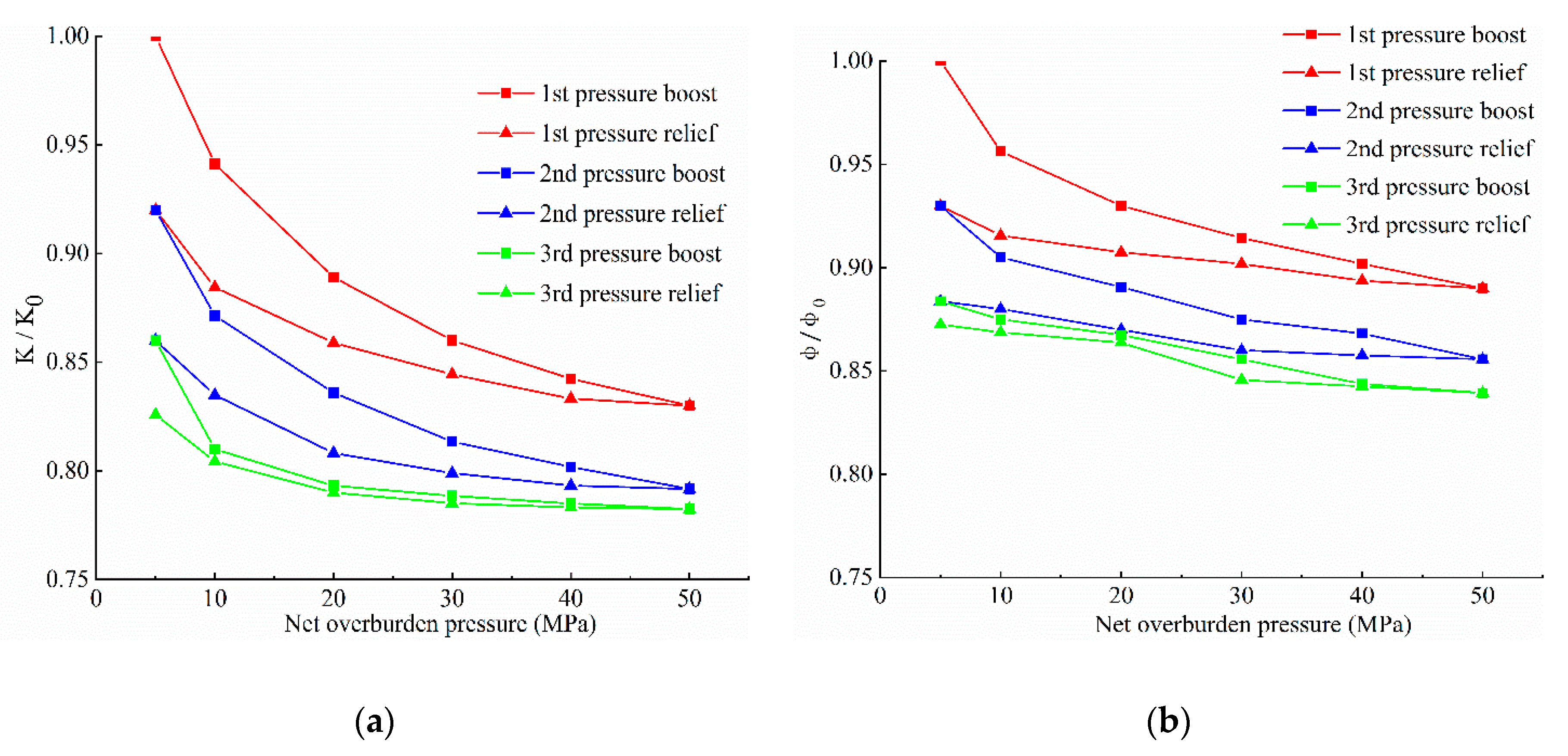
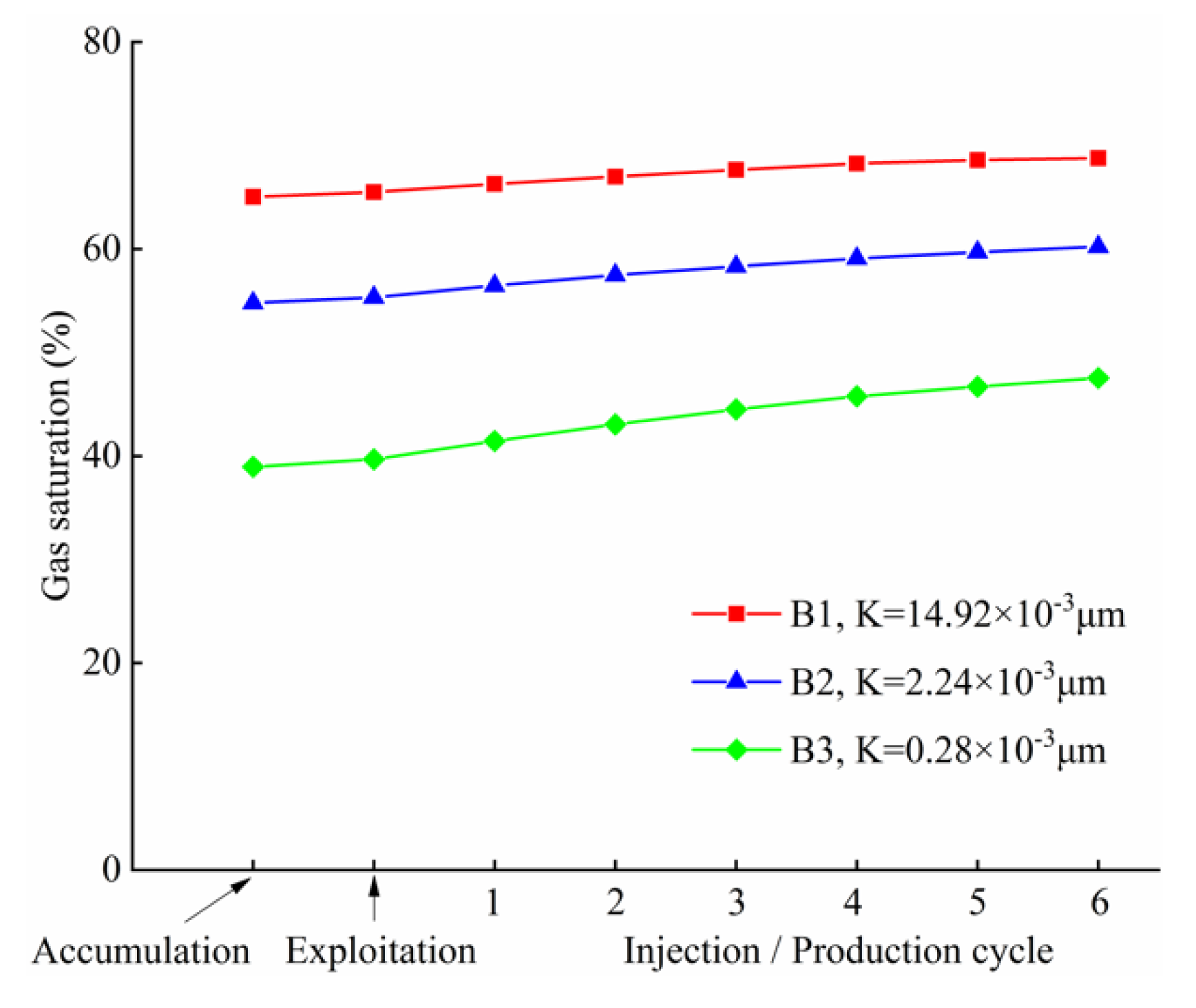
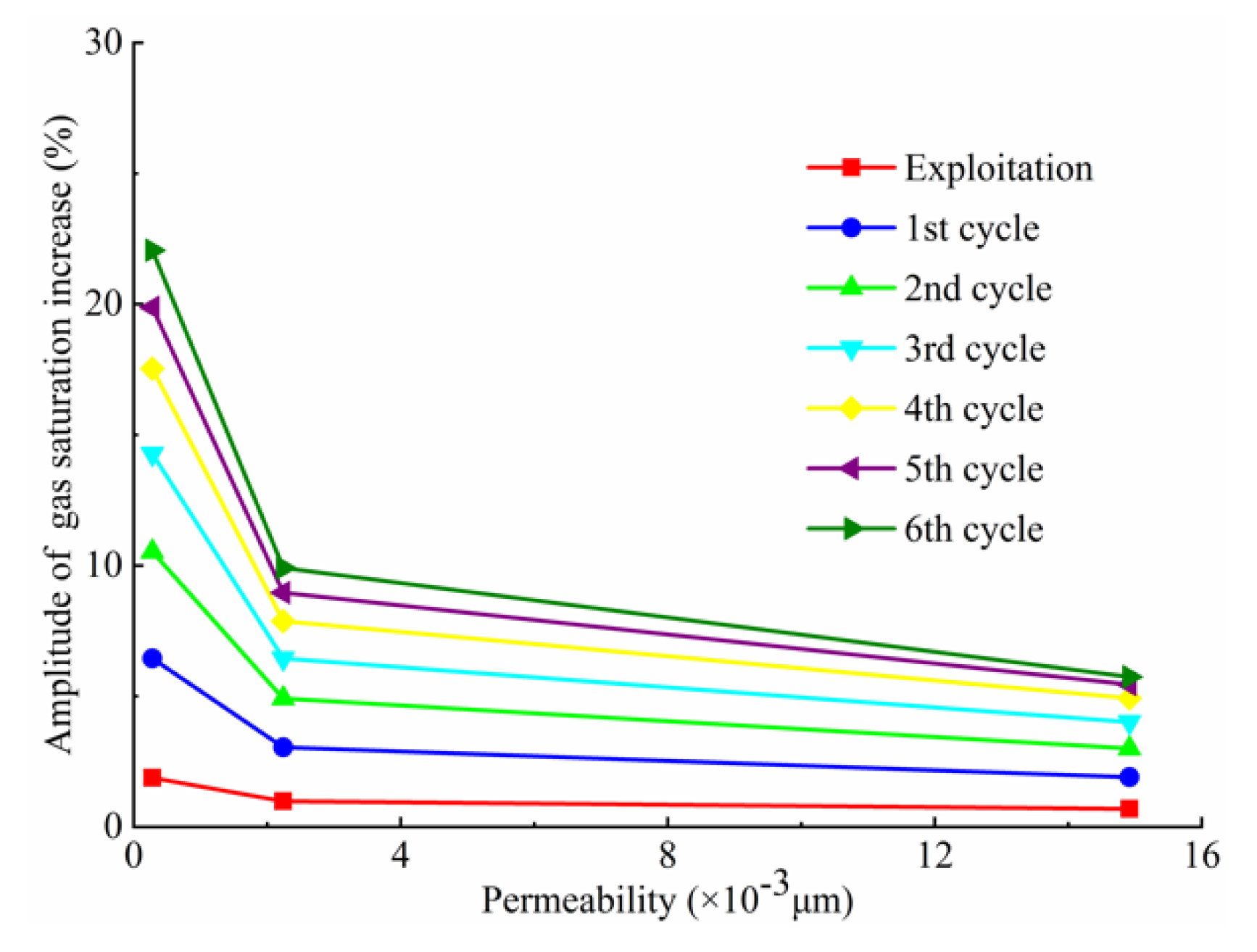

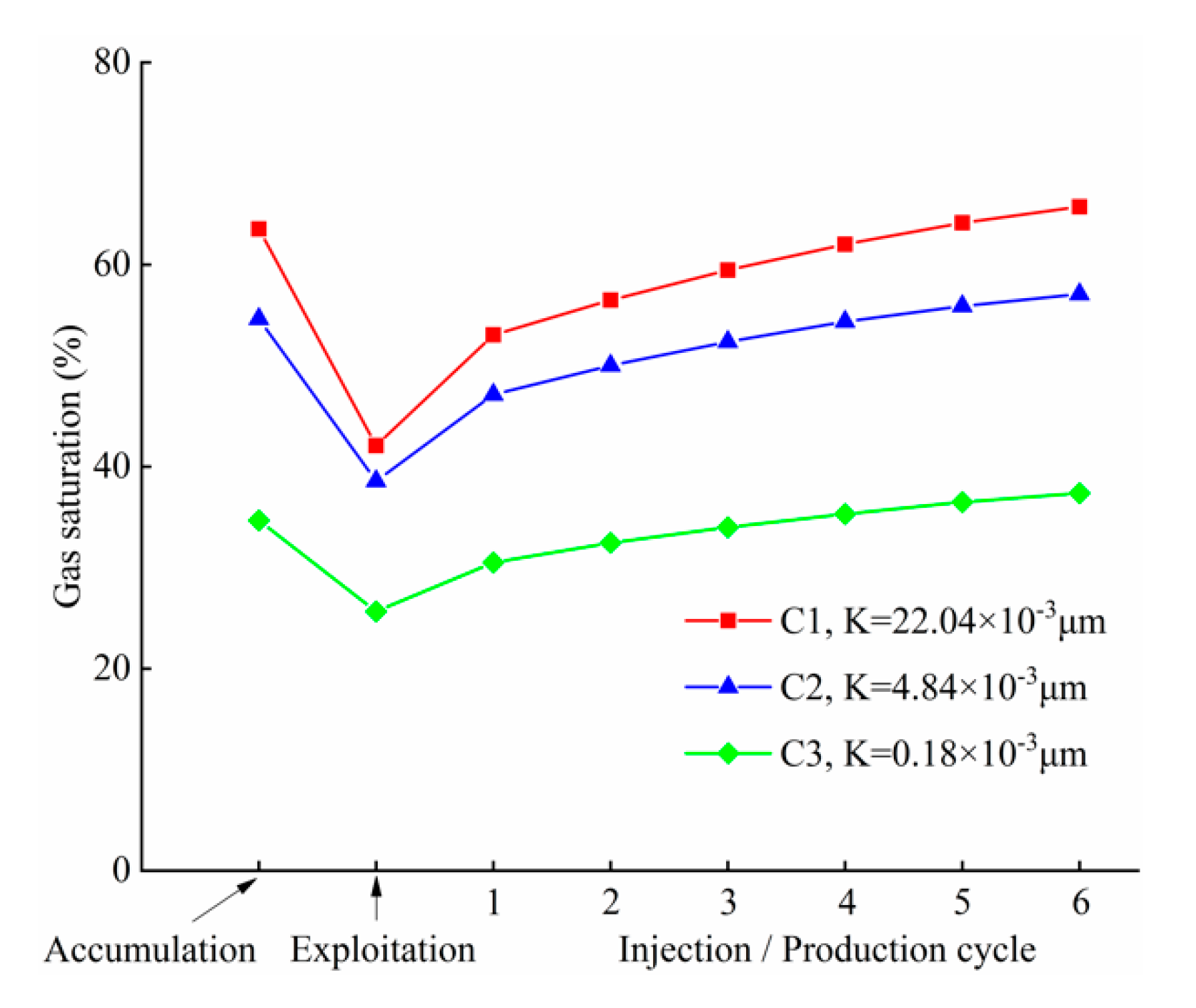
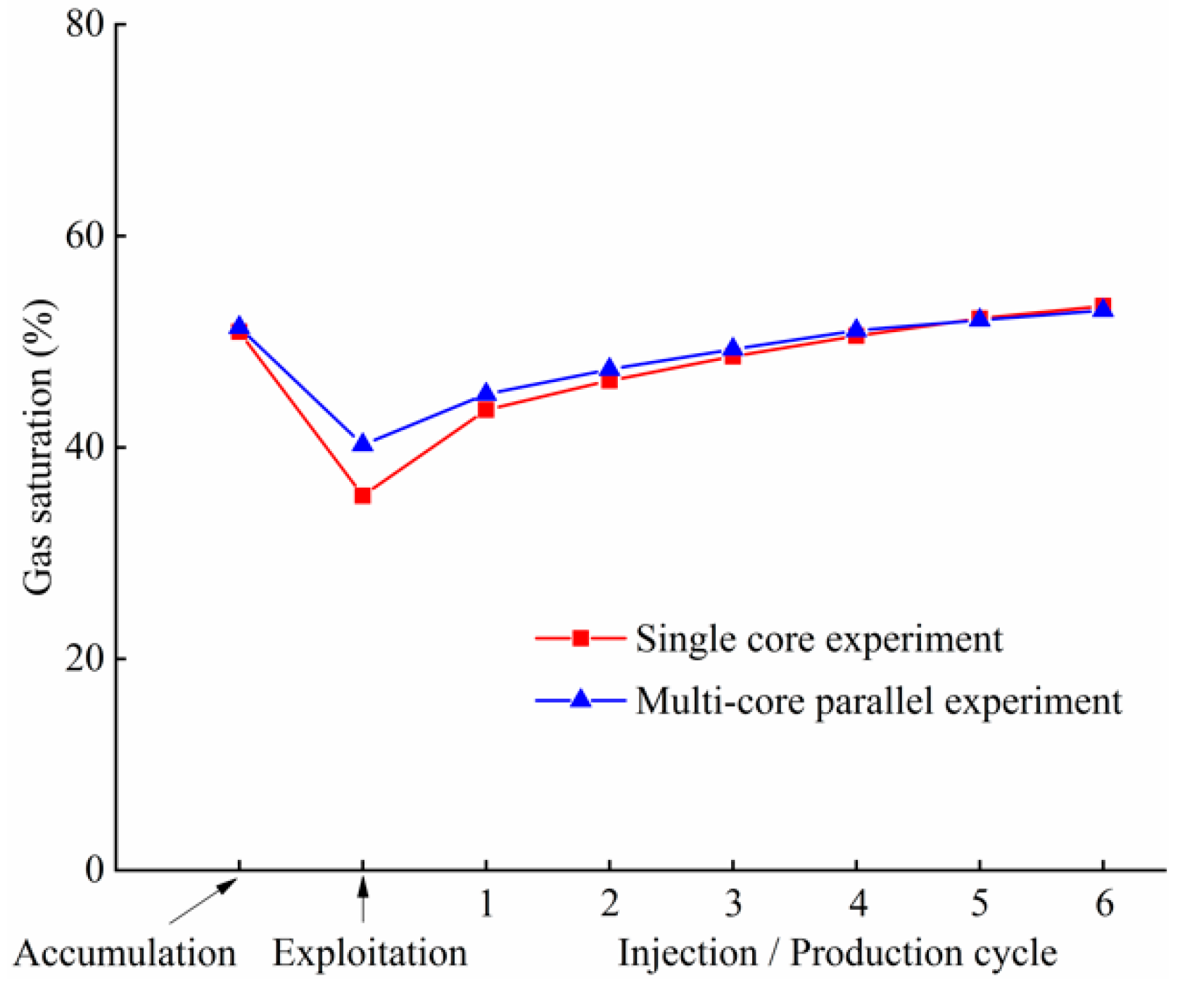


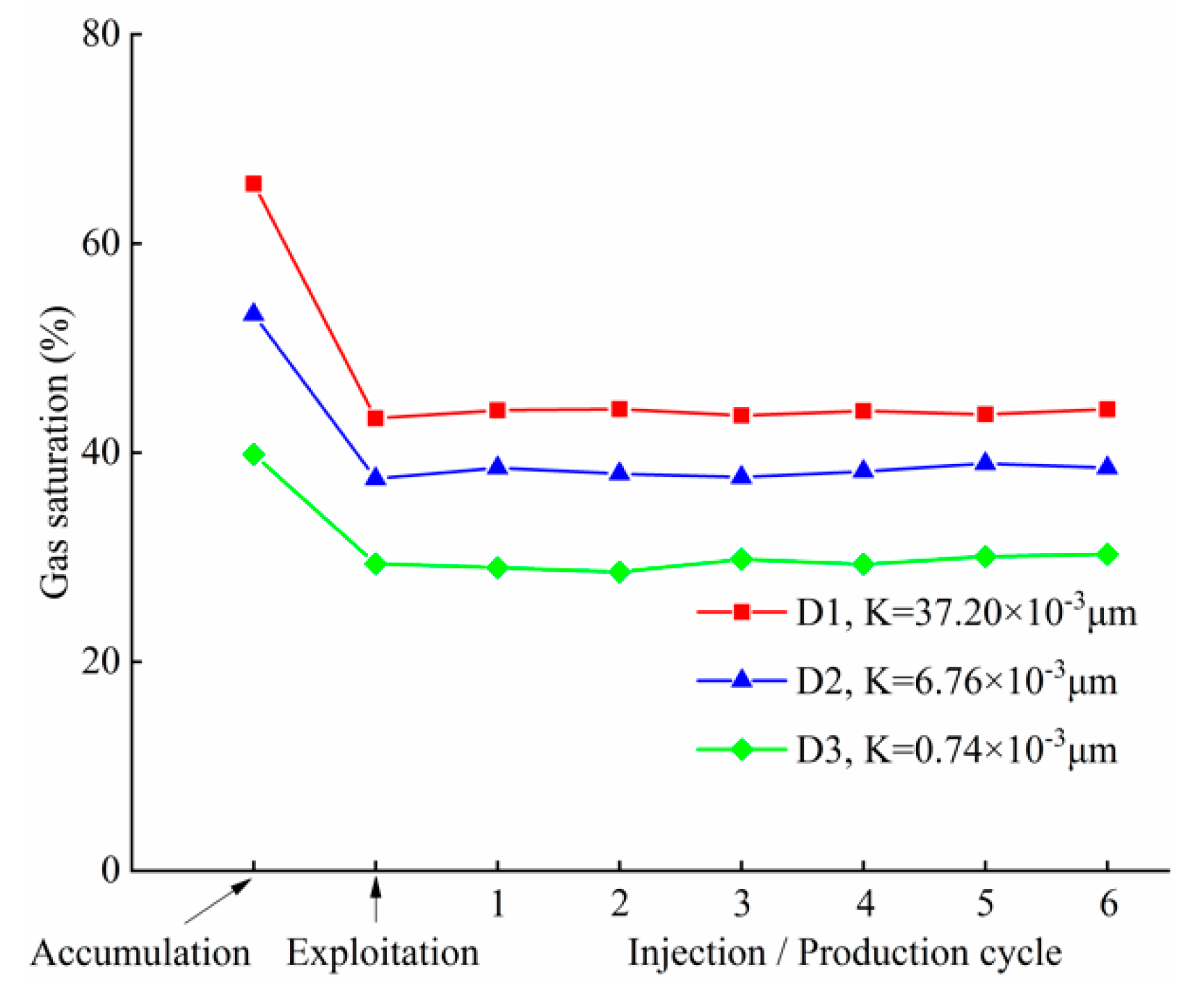
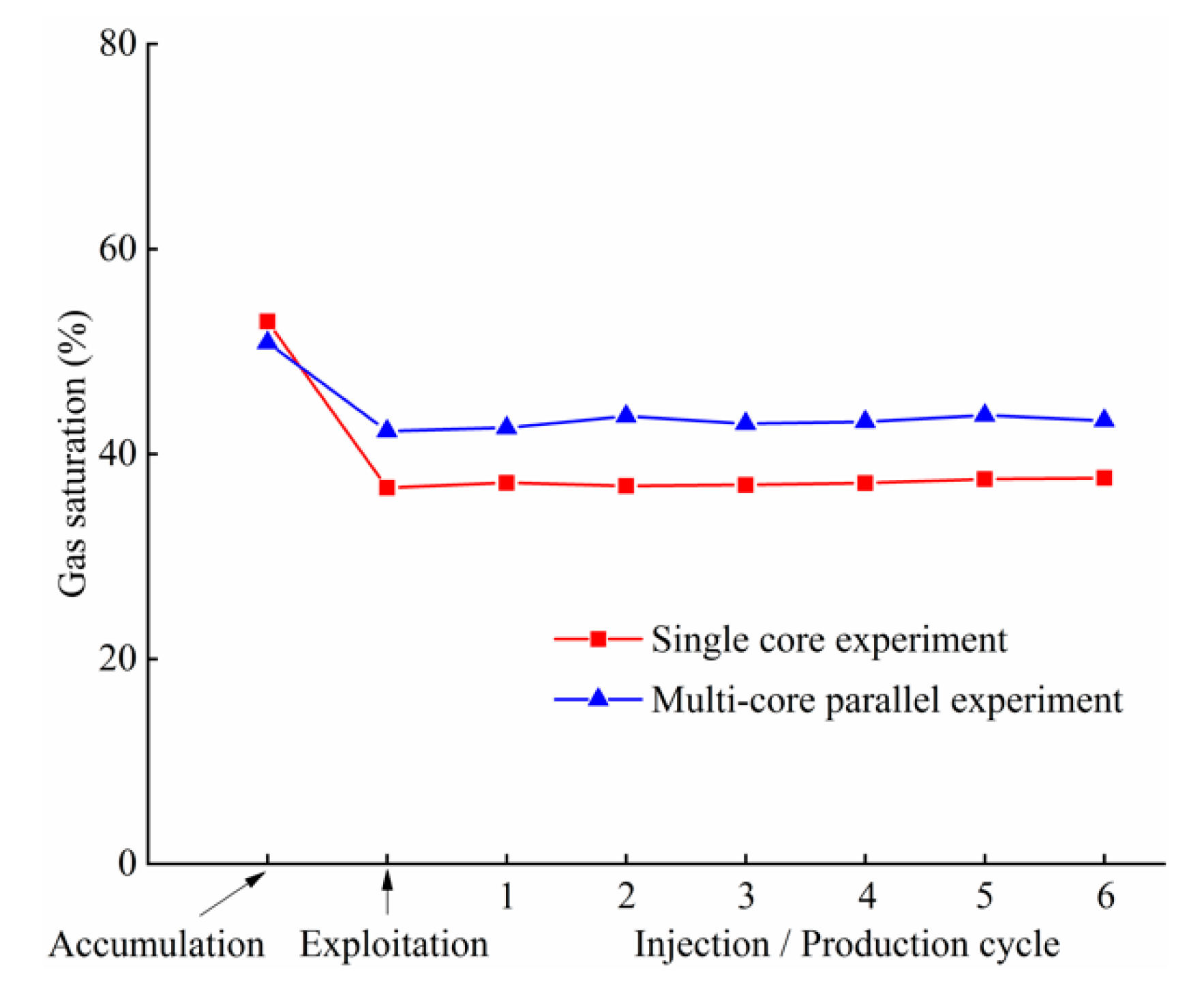
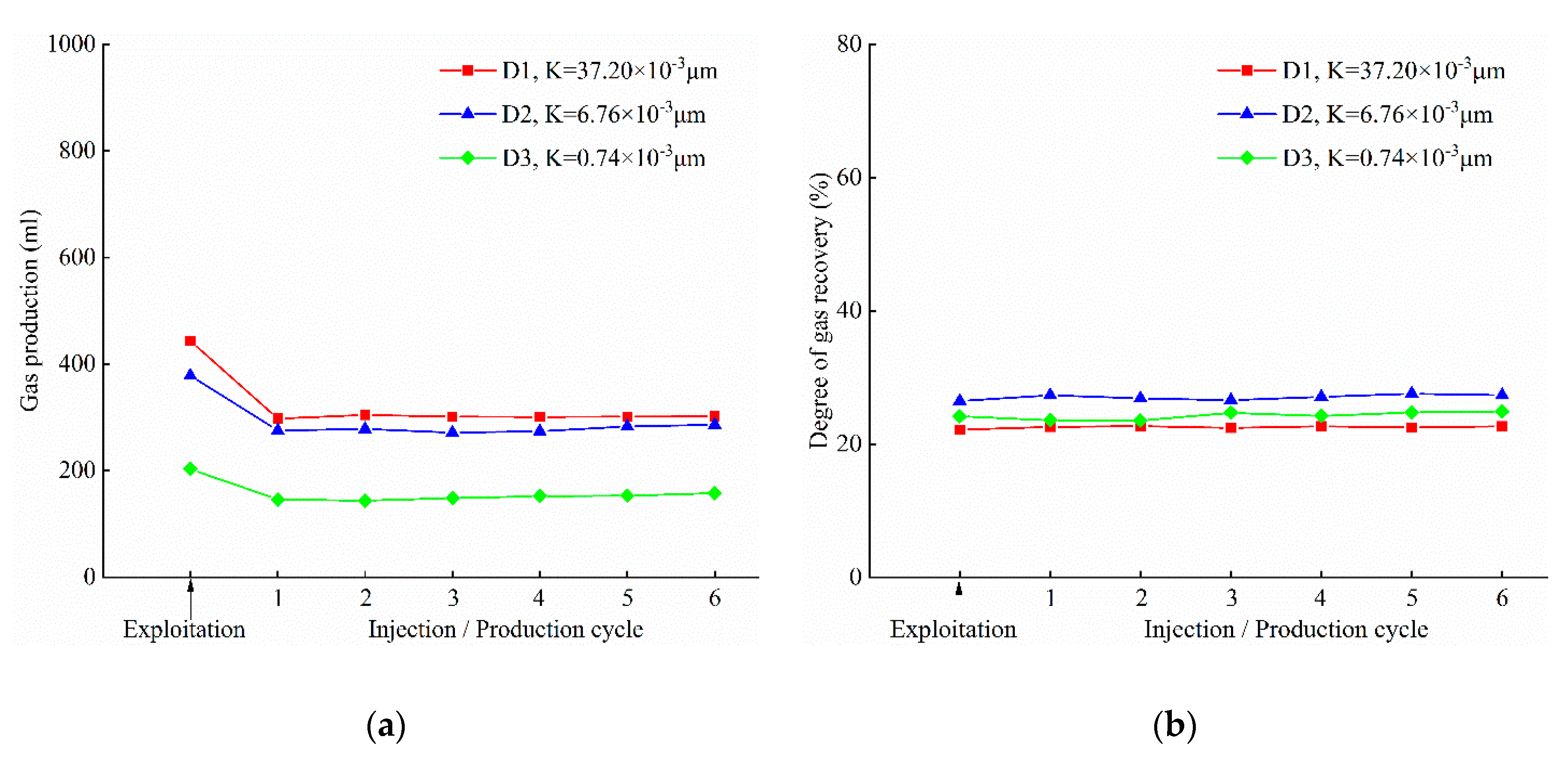
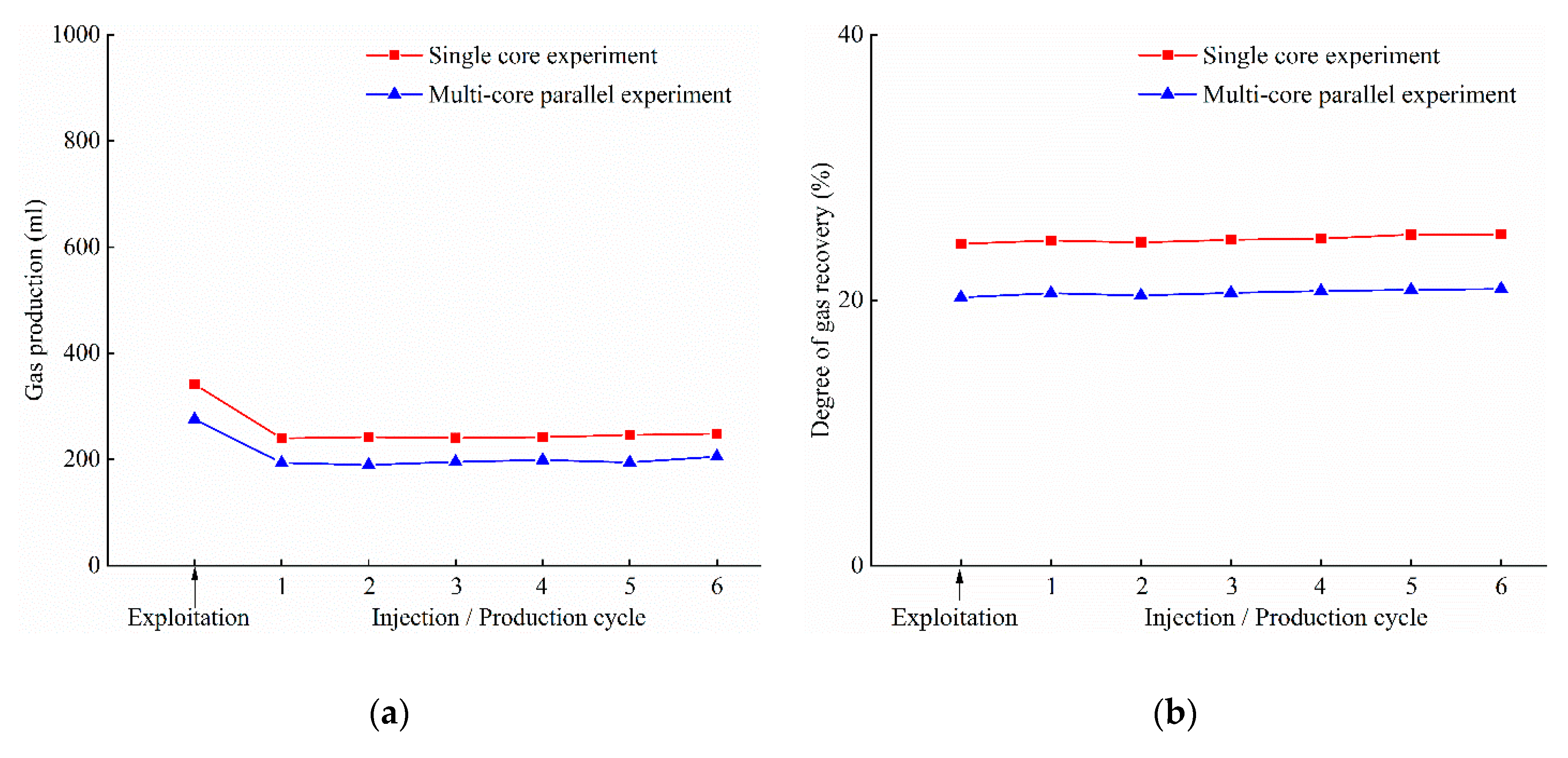
| Core No | Core Classifications | Permeability (×10−3 μm) | Porosity (%) |
|---|---|---|---|
| A1 | Class I | 12.16 | 16.56 |
| A2 | Class II | 3.24 | 13.42 |
| A3 | Class III | 0.32 | 9.67 |
| Simulation Zone | Core No | Core Classifications | Permeability (×10−3 μm) | Porosity (%) | Experiment Types |
|---|---|---|---|---|---|
| Pre-UGS gas zone | B1 | Class I | 14.92 | 14.74 | Single-core experiment |
| B2 | Class II | 2.24 | 12.24 | ||
| B3 | Class III | 0.28 | 11.48 | ||
| Gas-drive-water gas zone | C1 | Class I | 22.04 | 16.38 | Single-core experiment |
| C2 | Class II | 4.84 | 14.68 | ||
| C3 | Class III | 0.18 | 14.08 | ||
| C4 | Class I | 21.05 | 16.78 | Multi-core parallel experiment | |
| C5 | Class II | 9.03 | 15.86 | ||
| C6 | Class III | 0.27 | 12.27 | ||
| Gas-water transition zone | D1 | Class I | 37.20 | 20.11 | Single-core experiment |
| D2 | Class II | 6.76 | 17.74 | ||
| D3 | Class III | 0.74 | 13.50 | ||
| D4 | Class I | 25.74 | 17.68 | Multi-core parallel experiment | |
| D5 | Class II | 3.89 | 14.23 | ||
| D6 | Class III | 0.57 | 12.9 |
| Core No | 1st Pressure-Boost | 1st Pressure-Relief | 2nd Pressure-Boost | 2nd Pressure-Relief | 3rd Pressure-Boost | 3rd Pressure-Relief | |
|---|---|---|---|---|---|---|---|
| A1 | 3.5% | 1.7% | 2.68% | 0.92% | 0.76% | 0.34% | |
| 2.67% | - | 2.21% | - | 1.9% | - | ||
| A2 | 2.34% | 1.25% | 2.12% | 1.03% | 0.72% | 0.30% | |
| 1.35% | - | 0.78% | - | 0.32% | - | ||
| A3 | 1.88% | 1.23% | 1.42% | 0.82% | 0.67% | 0.42% | |
| 1.32% | - | 0.9% | - | 0.35% | - | ||
© 2020 by the authors. Licensee MDPI, Basel, Switzerland. This article is an open access article distributed under the terms and conditions of the Creative Commons Attribution (CC BY) license (http://creativecommons.org/licenses/by/4.0/).
Share and Cite
Zhang, J.; Fang, F.; Lin, W.; Gao, S.; Li, Y.; Li, Q.; Yang, Y. Research on Injection-Production Capability and Seepage Characteristics of Multi-Cycle Operation of Underground Gas Storage in Gas Field—Case Study of the Wen 23 Gas Storage. Energies 2020, 13, 3829. https://doi.org/10.3390/en13153829
Zhang J, Fang F, Lin W, Gao S, Li Y, Li Q, Yang Y. Research on Injection-Production Capability and Seepage Characteristics of Multi-Cycle Operation of Underground Gas Storage in Gas Field—Case Study of the Wen 23 Gas Storage. Energies. 2020; 13(15):3829. https://doi.org/10.3390/en13153829
Chicago/Turabian StyleZhang, Jie, Feifei Fang, Wei Lin, Shusheng Gao, Yalong Li, Qi Li, and Yi Yang. 2020. "Research on Injection-Production Capability and Seepage Characteristics of Multi-Cycle Operation of Underground Gas Storage in Gas Field—Case Study of the Wen 23 Gas Storage" Energies 13, no. 15: 3829. https://doi.org/10.3390/en13153829
APA StyleZhang, J., Fang, F., Lin, W., Gao, S., Li, Y., Li, Q., & Yang, Y. (2020). Research on Injection-Production Capability and Seepage Characteristics of Multi-Cycle Operation of Underground Gas Storage in Gas Field—Case Study of the Wen 23 Gas Storage. Energies, 13(15), 3829. https://doi.org/10.3390/en13153829





